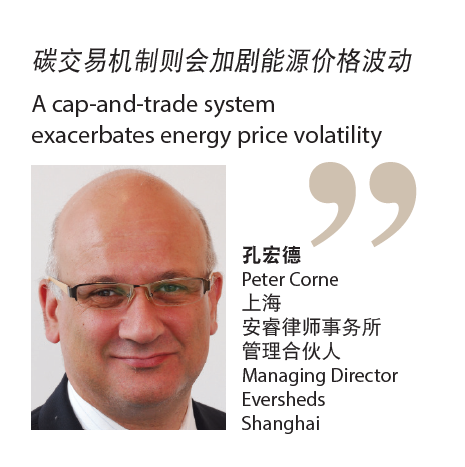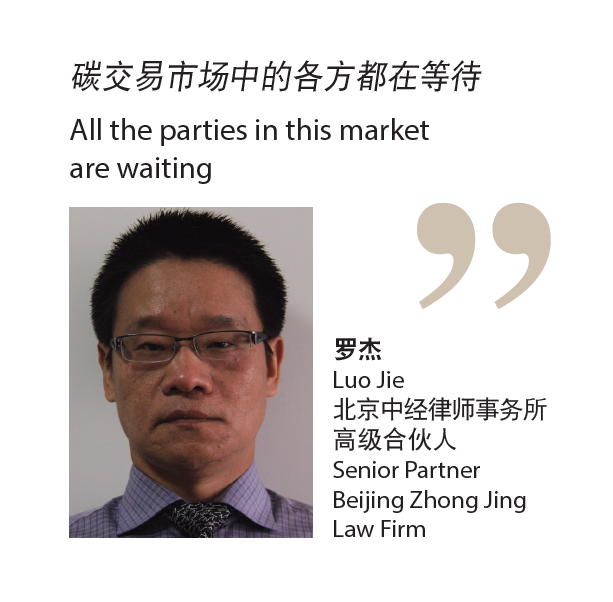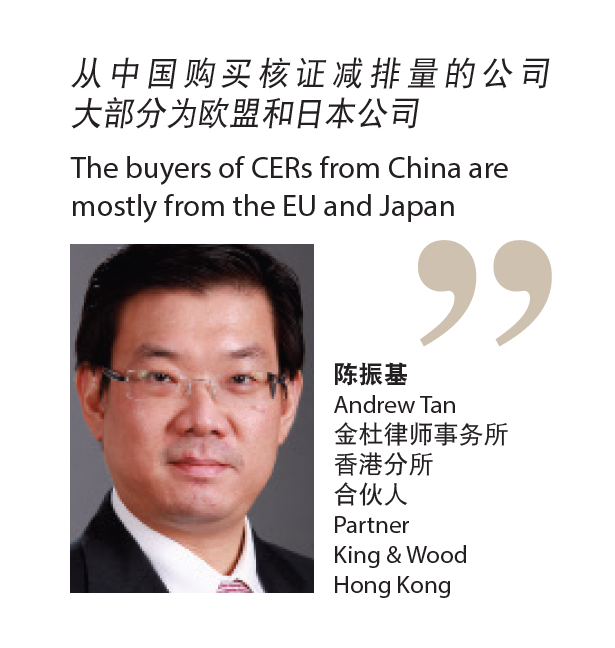Since the Kyoto Protocol came into force, Chinese companies have been selling carbon credits to buyers in developed countries. How have they done it, and what will happen when the first commitment period of the Kyoto Protocol expires in 2012?
By Alfred Romann and Simmie Magid
The man lining up to buy tickets outside Beijing railway station on 6 July was 27 years old. He was arranging a train trip – an activity that is not typically life-threatening – but he died. The cause of death was hyperthermia. He died because he was too hot.
During the summer just passed, Beijing experienced its longest heat wave in six decades, with temperatures topping 40 degrees Celsius. The scorching temperatures alone may not be evidence of global warming or pollution, but they provide anecdotal fodder for the debate on climate change. Less than a month after the headline-grabbing death in Beijing, the US National Oceans and Atmospheric Administration released new data showing “human fingerprints” in the changing temperatures.
The momentum towards legislative and regulatory change to combat global warming and pollution is powerful. Some four dozen developed countries already require emissions reporting from companies in a wide range of industries, and developing countries are rapidly following suit. In China, some kind of action on emissions is expected and likely to have a significant impact on business operations.

The most common approaches to control industrial emissions fall into two categories. One is taxes, the approach favoured in the US. China has been considering some kind of pollution tax since 2007.
The second is a cap-and-trade scheme, under which regulators set the maximum level of emissions that companies can emit. Companies that do not reach their cap can profit by trading away the leftover allowance through carbon exchanges, or by acquiring credits, explains Lonergan. Lonergan is the CEO of UK-based Total Global Steel, a metals trading company that has an interest in carbon trading and is the only foreign company to have been granted membership on the Beijing carbon exchange (see China carbon exchanges languish).
“It’s probably more achievable to have some sort of carbon tax,” says Peter Corne, managing director of the Shanghai office of Eversheds, who heads Eversheds’ renewables and climate change practice in China, as well as being head of the Energy Working Group of the Shanghai Chapter of the European-China Chamber of Commerce. “Carbon tax design and development would be a realistic path for government to take. It’s an easier way to put a price on carbon than a cap-and-trade system.
“Carbon tax provides for predictability on energy prices,” Corne adds. “It’s quicker and easier to implement; the public would find it easier to understand; and the revenue can be applied to emissions reduction projects. A cap-and-trade system exacerbates energy price volatility. Implementation is slower and more difficult, and special interests could conceivably more easily manipulate such a scheme.”
Under the Kyoto Protocol, whose clean development mechanism (CDM) pioneered cap-and-trade, developed countries must meet emissions reduction targets. There are no such targets for developing countries, including China. But the first commitment period of Kyoto comes to an end in 2012. With the central and most provincial-level governments increasingly committed to reducing emissions while creating a carbon market, either a tax on excess emissions, or a national cap-and-trade scheme (or both) seem to be in the cards.
“I’ve heard that there is a document in existence issued by the central government that refers to the possible introduction of an ‘environmental tax’ but the concept is still very vague,” says Corne. “We don’t really know where it’s leading. Obviously, there is a lot of work to do.
“I attended a seminar in Beijing earlier this month with officials from relevant departments and centres of policy research. The whole thrust was that while there may be pilot projects on carbon tax and cap-and-trade, we’re a long way from having a system on a national level. There’s a lot of experimentation to do.”
Carbon accounting
Around the world, companies are increasingly required to report their emissions in units that are equivalent to one tonne of carbon dioxide. This can be difficult and expensive. “Carbon accounting leads to some very complex areas,” Neil Stevenson, executive director of the Association of Chartered Certified Accountants (ACCA), said at an ACCA forum in July which focused on the emerging regulatory requirements of climate change.
The timing is uncertain, but sooner or later companies everywhere will have to report emissions, much like today they have to report their income. The Greenhouse Gas (GHG) Protocol – the accounting tool most widely used internationally to quantify and report GHG emissions – requires reporting of emissions produced by a company directly, emissions caused by its purchases of electricity and other utilities, and those caused by third parties acting for the company. In other words, a company is responsible not only for the emissions it produces by its own activities but also for those caused by its use of utilities and those generated by the transport of its supplies and finished products (see Reporting standards need a common approach on page 32).
Reporting is a necessary first step towards setting tax levels or putting in place a cap-and-trade scheme. For Chinese companies, reporting emissions will encourage adherence to reduction targets while giving authorities the ability to gauge reduction efforts and penalize enterprises that do not follow the rules – whatever form those rules eventually take.
There is, however, a carrot to go along with this imminent regulatory stick. The emerging legal infrastructure to control emissions will likely come with a parallel mechanism to trade in carbon credits and profit from reductions in carbon emissions.
China carbon exchanges languish
Trading in voluntary emissions reductions (VERs), which have not been certified under the Kyoto Protocol’s clean development mechanism (CDM), takes place on three exchanges in China.
In July 2008, the Chicago Climate Exchange set up China’s first carbon exchange in Tianjin in partnership with the city government and China National Petroleum Corporation Assets Management. Last year, Beijing set up a carbon exchange, which is operated by BlueNext. Shenzhen also operates an emissions trading scheme.
None of these exchanges is, as yet, particularly active. What little trading goes on involves VERs, with foreign companies such as international retailers WalMart and Tesco participating, partly to generate positive publicity. Mostly, the exchanges act as platforms to link various projects and participants.
From their start of trading to 31 May this year, the exchanges recorded a total of some 1,000 transactions amounting to about 10,000 tonnes of carbon dioxide, compared with a global total trade in 2009 of 93 million tonnes, according to Bloomberg.
“My clients never sell through those markets,” says Luo Jie, a partner at Beijing Zhong Jing Law Firm.
“We are sitting here waiting for some life to come into the exchange,” says Martin Lonergan, whose company, Total Global Steel, is a member of the Beijing exchange.
If the experience in Europe is any indication, that is likely to follow legislative changes. There, the trade in carbon has tracked economic growth.
Eventually, carbon prices are likely to correlate with those of oil, Lonergan says. They may also generate significant returns for participants.
For now, however, companies have to wait. China may be the biggest global supplier of certified emissions reductions but trade within China is not expected to grow noticeably, says Lu Xuedu, the vice-head of China’s National Climate Centre and a former member of the CDM executive board. Speaking at a conference in Beijing in June, Lu said the “domestic market will probably remain small, because you just need to ask the simple question – who will buy emissions in China?”. The only potential buyers, he said, are big corporations or celebrities looking for a public relations boost as under Kyoto, China is not required to make any emissions reductions.
Clean development mechanism
The CDM that is part of the Kyoto Protocol already permits companies in developed countries to meet their reduction targets by buying certified emission reductions (CERs) from developing countries. Since 2004, the CDM executive board has approved almost 2,300 projects around the world, about a third of them in China.
The CDM is managed by the United Nations Framework Convention on Climate Change and is one of three mechanisms adopted in 1997 under the Kyoto Protocol. The protocol sets carbon reduction targets that developed country signatories have to meet, and permits the sale of reductions that surpass a country’s target. China does not have to meet any reduction targets but can sell any verifiable reductions.
The CDM allows a country that has a reduction commitment under Kyoto to purchase CERs from the owners of emissions reduction projects in developing countries, such as China. The CERs, each equivalent to one tonne of carbon dioxide, can go towards meeting Kyoto targets.
“Under the current regulatory regime, only domestic or domestically controlled companies can sell CERs to offshore buyers,” says Eric Liu, a managing associate at Linklaters in Shanghai. David Tang, a partner at AllBright Law Offices in Shanghai, concurs. “Foreign-invested companies in which the foreign ownership is more than 49% are not qualified to initiate CDM projects in China,” he states. However, he adds that if there is already a foreign buyer for the CERs lined up, “the foreign buyer together with the Chinese partners may initiate the projects”.
The NDRC sets a minimum price requirement for the sale of CERs. “The parties may agree on a more flexible pricing mechanism so long as the ultimate price complies with [the NDRC] requirement,” adds Liu.
While the domestic control rule stands, a variation was introduced last year, says Andrew Tan, a partner in the Hong Kong office of King & Wood. Under the Supplementary Notes on the Implementation of Projects under the Clean Development Mechanism by Hong Kong Enterprises in the Mainland, issued on 1 December 2009 by the NDRC and Hong Kong’s Environmental Protection Department (EPD), a Hong Kong company which obtains a Letter of Certification issued by the EPD will be recognized as a Chinese enterprise by the NDRC in a CDM application (see China Business Law Journal volume 1 issue 4 page 70, National Treatment for Hong Kong Companies in CDM Projects).
“That means [the] Hong Kong company’s ownership interest in the PRC company undertaking the emission reduction project can be treated as Chinese-owned interest,” Tan says. “There is no restriction on foreign ownership of the Hong Kong company but its executive director, and more than half of its board of directors, must be PRC nationals or Hong Kong permanent residents.”
Growth of the market
China pumps out more than the equivalent of 100 million tonnes a year in CERs – 66% of the global market. India and Brazil got into the market before China, says Luo Jie, senior partner at Beijing Zhong Jing Law Firm, but China pulled ahead around 2008. “Before 2005 Chinese enterprises did not pay attention to the CDM system,” he says. “After the central government and experts conducted seminars and lectures, some factories and enterprises were finally persuaded to get involved.”
Luo had been counsel for a wind farm since 2000. When the enterprise decided to implement a CDM project in 2005, he became one of the first lawyers in China to advise on such projects.

“The buyers of CERs from China are mostly from the EU and Japan,” says Tan. The buyer could be a company set up by a governmental agency, a corporate that needs the credits to help meet its home country’s commitments, or a financial intermediary seeking trading profits.
“Because parties compete to buy such credits, very often the successful buyer needs to provide advance financial support to the PRC seller. For example, they may agree to supply at no cost to the PRC seller the equipment needed to be installed to achieve the emission reduction. In return, they secure the priority right to buy the credits created subsequently at a price approved by the NDRC,” Tan explains.
Corne acts for project companies and financiers in clean energy and CDM projects, as well as for intermediaries who buy CERs to on-sell elsewhere for a profit. Companies that need CERs for themselves are prone to use standardized contracts and are less likely to consult lawyers, he says. “Project developers who help to finance a project by purchasing CERs in advance, with a view to selling them on later, are naturally more concerned about their exposure and therefore want to spend more time on the contracts.”
Project financing is also available under the CDM. The World Bank, for example, has a unit dedicated to such financing. But producing CERs can be difficult and time consuming, with a long time lag between project development and the sale of a CER.
To qualify, CDM projects go through a public registration and issuance process and must be approved by a designated national authority, which in China is the NDRC in Beijing. The CDM executive board oversees the mechanism and gives final approval to projects.
The potential size of the carbon market – still in its infancy – is difficult to measure. In 2009, the global carbon trade was worth US$143 billion, up US$8 billion from a year earlier. Project-based transactions through the CDM amounted to a tiny fraction of that at US$2.6 billion, according to the World Bank.
CERs are currently selling for around €10 each, Luo says. Voluntary emission reductions (VERs), which have not been certified under the CDM, fetch lower prices. “The price has been US$2-3 recently, compared with €5 previously.” An emission reduction project can sell VERs while it awaits approval for CERs. “The price is low but it’s still money” and the contract is much simpler, he adds.
Purchase and sale of CERs
The creation and sale of CERs centres on an emissions reduction purchase agreement (ERPA), through which a buyer pays for carbon credits. The basic contracts have been standardized for years. A model ERPA published by the International Emissions Trading Association in 2004 is widely available.
The selling is not as complex as the emission reduction and certification process. The seller has to demonstrate that it has reduced its emissions, not just stopped producing. There are also requirements that the reduction be produced with only limited government help because subsidies, for example, could lead to trade disputes.
According to Tang, the verification of CERs is a multi-stage process. First, a qualified operational entity authorized by the CDM executive board will prepare a report. (The only authorized entity in China is the China Qualification Certification Centre.) Having obtained such a report, the project can apply to the CDM executive board for the CERs. At this stage, either the CDM executive board itself, or the contracting parties participating in the project, may ask for the report to be reviewed. If no such request is made, the CDM executive board will review the report and decide whether to issue the CERs.
Despite this process being well-established, however, Corne says there is concern about how reductions are measured. The CDM executive board has been reviewing wind power projects, concerned that the Chinese government has a policy of preferential pricing for wind projects, which would make them ineligible for CER production. According to various reports, the board is set to look at hydropower plants next.
Chinese projects are not the only ones to come under close scrutiny. “The last time I checked, proportionally, the EB’s rejection rate of Indian projects was much higher,” says Tan.
But the Kyoto Protocol is due to expire in 2012. With time running out, the CDM executive board has a backlog of more than 2,000 Chinese projects awaiting approval.
“Uncertainty about what will happen after 2012 has adversely impacted the number of projects that could have attracted foreign investment,” says Tan. “Some emissions reduction projects have still proceeded based on other revenues they can generate. The investors in the underlying project see CER revenue as icing, i.e. nice to have but still doable without.”
“All the parties in this market are waiting,” says Luo. “New applications are only for 2011 and 2012 and maybe a buyer is not interested in a two-year contract.”
Some longer-term contracts are being signed with, for example, the price after 2012 set at 80% of a reference price on BlueNext, an exchange founded by NYSE Euronext and Caisse des Dépôts in December 2007.
What of the future after 2012, when Kyoto expires? Dr Huang Ranwei, a professor of international studies at the Shanghai Academy of Social Sciences and the author of The Time and Space of China’s Rise, says China could become the biggest carbon trading centre in the world. The government appears to agree. With Kyoto’s demise imminent, China and its corporate sector await the likely announcement of the country’s own carbon trading scheme in the next five year plan. “If we cannot establish the (carbon) market, I don’t think the government will hit its 40%-45% carbon reduction target,” says Huang.
Reporting standards need a common approach
As the world’s biggest emitter of greenhouse gases but also, potentially, the biggest producer of tradable carbon securities, China has only dipped the tip of a toe into the ocean of options available to reduce emissions and create the infrastructure to trade.
Before the market can develop, authorities will have to agree on reporting standards. This is a question that has, so far, baffled authorities around the world. According to one study, 34 different reporting methodologies are in use and no agreement on a single global approach is in sight.
Still, sooner rather than later, companies are going to have to come to terms with legal requirements for reporting emissions and energy consumption; the cost of new taxes or permits; growing market pressures to reduce emissions; and emissions-related restrictions on trade. While the initial focus is likely to be on enterprises with high emissions, such as factories and mining operations, the tide is likely to cover everybody and fairly soon.
In the plus column, an increasing number of grants or tax breaks may be available for enterprises that act rapidly and decisively, and the first reductions are relatively easy. Companies in most sectors are likely to be able to lower emissions by a quarter through some simple steps.
Jennifer Westacott, a partner at KPMG in Australia who authored a report on how companies can best tackle this situation, says the risks will “drastically affect the competitive landscape for most companies”.
Companies that operate internationally are likely to find that operations in different jurisdictions will have to comply with different emissions reporting standards. And that could become an expensive proposition.
Such standards are the necessary precursor to a carbon tax, says Westacott – an alternative, or possibly an addition, to carbon trading schemes.






















